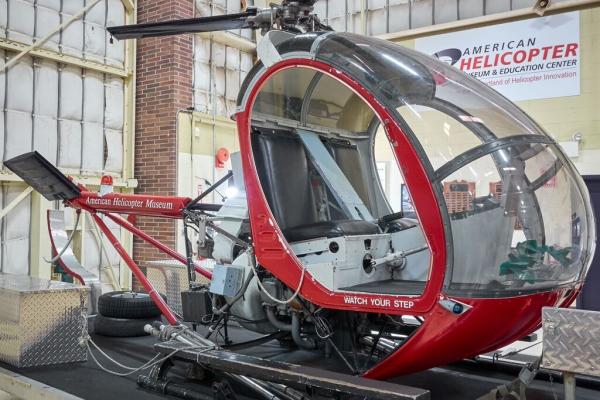
First Flight: October 1956
Restored by Museum volunteers
Data from The Illustrated Encyclopedia of Helicopters by Giorgio Apostolo
The Hughes Aircraft Company was established in 1936 as a subsidiary of the Hughes Tool Company. Under the direction of Howard Hughes, Hughes Aircraft built several unusual aircraft, including the world’s largest airplane, the “Spruce Goose.” A market survey carried out in 1955, suggesting that a market existed for a low‑cost, light weight two‑seat helicopter, led to the construction of the Model 269 in September 1955. This helicopter had a fully‑glazed cockpit with side‑by-side accommodation for two, an open‑framework fuselage, and a three‑blade articulated rotor. The prototype flew in October 1956; commercial deliveries began in October, 1961.
An improved version, the Model 269A, had a redesigned, more compact cockpit and a steel tube fuselage. The landing skids were curved upwards at the front, and two small wheels could be added to facilitate ground handling. There was a small asymmetrical butterfly tail unit. The project was submitted to the US Army who ordered five, designated YHO‑2‑HU, for evaluation at Fort Rucker. Recommendations by Army engineers were adopted by Hughes to improve the design. In the summer of 1964, the Army chose it as a primary trainer and ordered 20, designated TH‑55A Osage. Two subsequent orders brought the total number of the Osages in 1965 to 396. In 1967, another order was received, bringing the total to 792. Deliveries ended in March of 1969.
| Aircraft Specifications | |
|---|---|
| Rotor Diameter | 25 ft 3 in |
| Fuselage Length | 22 ft 4 in |
| Maximum Speed | 90 mph |
| Cruise Speed | 85 mph |
| Height | 8 ft 9 in |
| Empty Weight | 1,045 lbs |
| Gross Weight | 1,669 lbs |
| Engine | 160 hp Lycoming H10-360-B1A |
This aircraft is available for “adoption” in the Museum’s Adopt-a-Copter program.